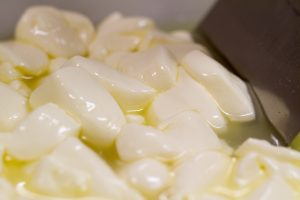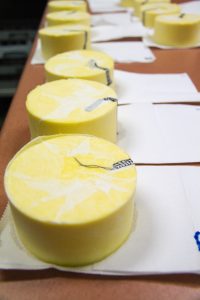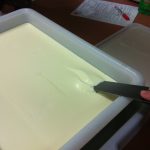This is the most complex technical blog article I have written. It is an important area of cheese making so I thought something should be written on this subject. However, when I started writing, the explanations I tried to provide became messy and confusing to me as the writer and the message I wanted to provide to you as the cheesemaker. However, I persisted. It is a complex subject to write on because it is stretching the level of my technical understanding of cheesemaking; we cannot see demineralisation happening when we make our cheese, so we assume it will just happen for us; you cannot directly measure or see or feel it is happening as you can many other aspects of cheesemaking; and it is assumed that demineralisation will automatically occur for us. If you have any contributions or comments on this article, I would be very interested in your feedback at info@cheesemaking.com.au
Forming a curd is an essential step for making cheese. The milk proteins consist of approximately 80% casein and the remaining 20% are whey proteins. The casein micelles i n milk repel each other due to the κ-casein. When rennet is added to the milk, the κ-casein micelles change their repelling action and start to agglomerate to form a loose network of micelles. The calcium in the milk gradually but slowly acts as a glue to hold the casein micelles together. Flocculation is the first sign of this agglomeration happening. Basically, the curd is just starting to set (flocculation point), but the curd is still very, very soft and fragile at this stage. This structure keeps gradually strengthening until a suitably firm curd is formed. At this point the cheesemaker recognises the cheese as being set (hardening stage).
n milk repel each other due to the κ-casein. When rennet is added to the milk, the κ-casein micelles change their repelling action and start to agglomerate to form a loose network of micelles. The calcium in the milk gradually but slowly acts as a glue to hold the casein micelles together. Flocculation is the first sign of this agglomeration happening. Basically, the curd is just starting to set (flocculation point), but the curd is still very, very soft and fragile at this stage. This structure keeps gradually strengthening until a suitably firm curd is formed. At this point the cheesemaker recognises the cheese as being set (hardening stage).
There are several minerals in milk, such as calcium, phosphorus, potassium, magnesium, iodine and several others. These minerals are very minor in volume compared to their fellow constituents such as water, fat, protein and lactose. Calcium in milk exists in two forms: the most important for cheesemaking is where the calcium is present as a colloidal calcium phosphate (CCP) which is bound to the casein micelles and provides some stability and structure to those micelles. The second form is soluble or free calcium and exists in the liquid phase of the milk, or simply it floats around in the liquid part of the milk.
However, calcium, as minor as it may be in volume, is the glue that bonds the casein micelles after the rennet has been added to the milk. The calcium is essential to forming a firm curd. Milk that has been stored for long periods, stored below 4°C, from drought or flooded areas, or pasteurised may cause the calcium to change from colloidal to a solubilised form. If the cheesemaker takes no action, the flocculation point takes longer to occur and the curd hardening point is slow or the curd may not even reach maximum hardening. Such a curd will be very fragile and will have poor draining factors. Many cheesemakers will add calcium chloride to increase the available calcium in the milk to offset these problems. Calcium chloride ideally should be added to the milk as soon as the milk warms, to give the calcium enough time to bind with the calcium and phosphorous in the milk. If you add the calcium chloride immediately prior to adding rennet, you may as well not add it.
When rennet is added to the milk, the casein is forced to separate from the water phase and entraps the fat, the water (only temporarily until synereses occurs), the minerals and any of the dissolved substances in the water. This is the start of coagulation. The process of syneresis is where the curd ‘contracts and moisture in the form of whey is expelled from the curd.
For some cheese varieties, the production of lactic acid does not play a part, as no starter culture is added. The curd is formed 100% by the rennet. Some halloumi may be made this way and a Brazilian cheese called Minas.
Lactic acid coagulated cheese varieties occur when the milk is warmed to between 18°C to 25°C and lactic acid is developed in the cheese over several hours or longer by the lactic acid starter cultures. Often, a very small amount of rennet is also added to aid curd formation and drainage at the hooping and post hooping stages. With the long incubation period, the milk pH reaches the isoelectric point of casein at pH 4.6 at which point a curd is formed. In many cases, the curd continues to acidify below pH 4.6. The increase in acid neutralises the surface polarity of the casein micelles, thereby rendering those micelles incapable of interacting with the water component of the curd. As the pH continues to decrease, the casein micelles bind with each other to form a mesh network that entraps all the water and the solid of the curd. The gel that is formed is very fragile. Over the course of several hours, the milk is thus transformed from a liquid state to a soft, very fragile curd. The casein matrix that gives the coagulum its structure is highly demineralized because most of the micellar calcium phosphate is dissolved by the high concentration of lactic acid and low pH needed to initiate coagulation. This is called a highly demineralised curd.
For a rennet set curd, which makes up most cheese varieties, the curd is more resilient to breakage and is less fragile than rennet or acid curds. The rennet usually works to form a firm set within 30 to 40 minutes of the rennet being added. The small amount of acid produced by the starter culture in conjunction with the rennet can contract the curd and push moisture from the curd. Because of the lower rate of acidification and the higher level of rennet added, compared to lactic acid curd, coagulation usually occurs within 30 to 60 minutes and the pH of the curd may drop to a pH of approximately 6.6 to 6.5 in this time. This leaves the curd with a much higher level of calcium within the curd and it is considered partially demineralised. A second difference is that rennet coagulation occurs very rapidly (within 30 to 60 min) due to the higher concentration of rennet and the moderate level of acidity (pH 6.6 to 6.3). Consequently, rennet curd is much richer in calcium phosphate than the highly demineralized curd that forms during acid coagulation.

However, there is a large variation in the acid production profile of rennet set cheeses. When the curd becomes acidified while it is still in the curds and whey stage, a large proportion of the calcium ions in the curd will be removed from the curd along with the whey. If the pH of the curd just prior to hooping drops to around a pH of 6.3 or lower, this is sufficient demineralisation of the curd to give the cheese a chalky and crumbly body in the finished cheese. Examples are English acid cheeses, acidic white cheeses such as Greek Feta and lactic set cheeses.
For softer, higher moisture styles of cheese, such as Camembert and Brie, soft washed rind styles, the aim i
s to have minimal demineralisation of the curd during the curds and whey stage. The hooping of the curd is usually completed above a pH of 6.4. The hooped curds for these styles of cheeses are larger in size by comparison to the more ‘acidic’ styles of cheese. Because of the additional lactose in the curd particles, acidification is carried out in the hoop (post-hooping acidification). This allows the minerals within the curds to remain ‘trapped’ within the hoop leading to lower demineralisation of the curd. Even if the day 2 pH of a Camembert and a Cheddar may both be around pH 5.1, the Camembert will have a greater mineral content than the Cheddar.
For cheeses that have a curd washing step, e.g. Edam, Gouda, Havarti and many Swiss styles, these cheeses also have lower demineralisation of the curd, and this leads to the curd having a flexible, more flexible and pliable body.
As a general rule, soft paste cheeses generally have a higher water and lower mineral content than pressed, uncooked styles. These softer style cheeses are more susceptible to losing shape during affinage. For example, soft paste cheeses like Brie and traditional Camembert are known for becoming runnier as they ripen. Conversely, ‘modern’ Brie, more mineralized, holds its shape more as the cheese ages.



